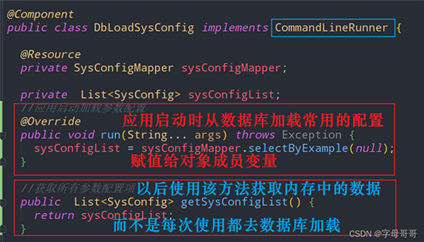springboot應用程式服務啟動事件的監聽怎麼實現
一、簡介
Spring Boot提供了兩個介面:CommandLineRunner、ApplicationRunner,用於啟動應用程式時做特殊處理,這些程式碼會在SpringApplication的run()方法運行完成之前被執行。相對於之前章節為大家介紹的Spring的ApplicationListener介面自訂監聽器、Servlet的ServletContextListener監聽器。 使用二者的好處在於,可以方便的使用應用啟動參數,根據參數不同做不同的初始化操作。
二、常用場景介紹
實作CommandLineRunner和ApplicationRunner介面。通常用於應用啟動前的特殊程式碼執行,例如:
將系統常用的資料載入到記憶體
應用程式上一次運行的垃圾資料清理
系統啟動成功後的通知的發送等
#我透過實作CommandLineRunner接口,在應用程式啟動時載入了系統內常用的配置數據,如下圖所示。從資料庫載入到內存,以後使用該資料的時候只需要呼叫getSysConfigList方法,不需要每次使用該資料都去資料庫載入。節省系統資源、縮減資料載入時間。

二、程式碼小實驗透過@Component定義方式實作
CommandLineRunner:參數是字串陣列
@Slf4j
@Component
public class CommandLineStartupRunner implements CommandLineRunner {
@Override
public void run(String... args){
log.info("CommandLineRunner传入参数:{}", Arrays.toString(args));
}
}ApplicationRunner:參數被放入ApplicationArguments,透過getOptionNames()、getOptionValues()、getSourceArgs()取得參數
@Slf4j
@Component
public class AppStartupRunner implements ApplicationRunner {
@Override
public void run(ApplicationArguments args) {
log.info("ApplicationRunner参数名称: {}", args.getOptionNames());
log.info("ApplicationRunner参数值: {}", args.getOptionValues("age"));
log.info("ApplicationRunner参数: {}", Arrays.toString(args.getSourceArgs()));
}
}透過@Bean定義方式實作
這種方式可以指定執行順序,注意前兩個Bean是CommandLineRunner,最後一個Bean是ApplicationRunner 。
@Configuration
public class BeanRunner {
@Bean
@Order(1)
public CommandLineRunner runner1(){
return new CommandLineRunner() {
@Override
public void run(String... args){
System.out.println("BeanCommandLineRunner run1()" + Arrays.toString(args));
}
};
}
@Bean
@Order(2)
public CommandLineRunner runner2(){
return new CommandLineRunner() {
@Override
public void run(String... args){
System.out.println("BeanCommandLineRunner run2()" + Arrays.toString(args));
}
};
}
@Bean
@Order(3)
public ApplicationRunner runner3(){
return new ApplicationRunner() {
@Override
public void run(ApplicationArguments args){
System.out.println("BeanApplicationRunner run3()" + Arrays.toString(args.getSourceArgs()));
}
};
}
}可以透過@Order設定執行順序
三、執行測試
#在IDEA Springboot啟動設定中加入下列參數,儲存後啟動應用程式

#測試輸出結果:
c.z.boot.launch.config.AppStartupRunner : ApplicationRunner參數名稱: [name, age]
c.z.boot.launch.config. AppStartupRunner : ApplicationRunner參數值: [18]
c.z.boot.launch.config.AppStartupRunner : ApplicationRunner參數: [--name=zimug, --age=18]#BeanApplicationRunner run3()[-- name=zimug, --age=18]
c.z.b.l.config.CommandLineStartupRunner : CommandLineRunner傳入參數:[--name=zimug, --age=18]
BeanCommandLineRunner run1()[--name =zimug, --age=18]
e=18]
BeanCommandLineRunner run2()[--name=zimug, --age=18]
#筆者經過多次測試發現,在測試結果中,這個優先順序一直如此,但目前無法確定這是否為常態
ApplicationRunner執行優先權高於CommandLineRunner
#以Bean的形式運行的Runner優先權要低於Component註解加上implements Runner介面的方式
Order註解只能保證同類的CommandLineRunner或ApplicationRunner的執行順序,不能跨類別保證順序
四、總結
CommandLineRunner、ApplicationRunner的核心用法是一致的,就是用來應用啟動前的特殊程式碼執行。 ApplicationRunner的執行順序先於CommandLineRunner;ApplicationRunner將參數封裝成了對象,提供了取得參數名稱、參數值等方法,操作上會方便一些。
五、問題總結
這是筆者在實務上真實遇到的問題,就是我定義了多個CommandLineRunner的實作。出現奇怪的問題是:當你定義多個CommandLineRunner的實作的時候,其中一個或幾個將不會執行。
分析:下面的程式碼是SpringBootApplication啟動專案之後會執行的程式碼,大家看程式碼中透過一個遍歷來啟動CommandLineRunner或是ApplicationRunner。也就是說,只有上一個CommandLineRunner執行完成之後,才會執行下一個CommandLineRunner,是同步執行的。
private void callRunners(ApplicationContext context, ApplicationArguments args) {
List<Object> runners = new ArrayList<>();
runners.addAll(context.getBeansOfType(ApplicationRunner.class).values());
runners.addAll(context.getBeansOfType(CommandLineRunner.class).values());
AnnotationAwareOrderComparator.sort(runners);
for (Object runner : new LinkedHashSet<>(runners)) {
if (runner instanceof ApplicationRunner) {
callRunner((ApplicationRunner) runner, args);
}
if (runner instanceof CommandLineRunner) {
callRunner((CommandLineRunner) runner, args);
}
}
}所以,如果在CommandLineRunner某個實作run 方法體中呼叫了同步阻塞的API或是一個 while(true) 循環,在遍歷中處於該CommandLineRunner之後的其他實作將不會被執行。
以上是springboot應用程式服務啟動事件的監聽怎麼實現的詳細內容。更多資訊請關注PHP中文網其他相關文章!

熱AI工具

Undresser.AI Undress
人工智慧驅動的應用程序,用於創建逼真的裸體照片

AI Clothes Remover
用於從照片中去除衣服的線上人工智慧工具。

Undress AI Tool
免費脫衣圖片

Clothoff.io
AI脫衣器

Video Face Swap
使用我們完全免費的人工智慧換臉工具,輕鬆在任何影片中換臉!

熱門文章

熱工具

記事本++7.3.1
好用且免費的程式碼編輯器

SublimeText3漢化版
中文版,非常好用

禪工作室 13.0.1
強大的PHP整合開發環境

Dreamweaver CS6
視覺化網頁開發工具

SublimeText3 Mac版
神級程式碼編輯軟體(SublimeText3)
 Springboot怎麼整合Jasypt實現設定檔加密
Jun 01, 2023 am 08:55 AM
Springboot怎麼整合Jasypt實現設定檔加密
Jun 01, 2023 am 08:55 AM
Jasypt介紹Jasypt是一個java庫,它允許開發員以最少的努力為他/她的專案添加基本的加密功能,並且不需要對加密工作原理有深入的了解用於單向和雙向加密的高安全性、基於標準的加密技術。加密密碼,文本,數字,二進位檔案...適合整合到基於Spring的應用程式中,開放API,用於任何JCE提供者...添加如下依賴:com.github.ulisesbocchiojasypt-spring-boot-starter2. 1.1Jasypt好處保護我們的系統安全,即使程式碼洩露,也可以保證資料來源的
 怎麼在SpringBoot中使用Redis實現分散式鎖
Jun 03, 2023 am 08:16 AM
怎麼在SpringBoot中使用Redis實現分散式鎖
Jun 03, 2023 am 08:16 AM
一、Redis實現分散式鎖原理為什麼需要分散式鎖在聊分散式鎖之前,有必要先解釋一下,為什麼需要分散式鎖。與分散式鎖相對就的是單機鎖,我們在寫多執行緒程式時,避免同時操作一個共享變數產生資料問題,通常會使用一把鎖來互斥以保證共享變數的正確性,其使用範圍是在同一個進程中。如果換做是多個進程,需要同時操作一個共享資源,如何互斥?現在的業務應用通常是微服務架構,這也意味著一個應用會部署多個進程,多個進程如果需要修改MySQL中的同一行記錄,為了避免操作亂序導致髒數據,此時就需要引入分佈式鎖了。想要實現分
 SpringBoot怎麼整合Redisson實現延遲隊列
May 30, 2023 pm 02:40 PM
SpringBoot怎麼整合Redisson實現延遲隊列
May 30, 2023 pm 02:40 PM
使用場景1、下單成功,30分鐘未支付。支付超時,自動取消訂單2、訂單簽收,簽收後7天未進行評估。訂單超時未評價,系統預設好評3、下單成功,商家5分鐘未接單,訂單取消4、配送超時,推播簡訊提醒…對於延時比較長的場景、即時性不高的場景,我們可以採用任務調度的方式定時輪詢處理。如:xxl-job今天我們採
 springboot讀取檔案打成jar包後存取不到怎麼解決
Jun 03, 2023 pm 04:38 PM
springboot讀取檔案打成jar包後存取不到怎麼解決
Jun 03, 2023 pm 04:38 PM
springboot讀取文件,打成jar包後訪問不到最新開發出現一種情況,springboot打成jar包後讀取不到文件,原因是打包之後,文件的虛擬路徑是無效的,只能通過流去讀取。文件在resources下publicvoidtest(){Listnames=newArrayList();InputStreamReaderread=null;try{ClassPathResourceresource=newClassPathResource("name.txt");Input
 Springboot+Mybatis-plus不使用SQL語句進行多表新增怎麼實現
Jun 02, 2023 am 11:07 AM
Springboot+Mybatis-plus不使用SQL語句進行多表新增怎麼實現
Jun 02, 2023 am 11:07 AM
在Springboot+Mybatis-plus不使用SQL語句進行多表添加操作我所遇到的問題準備工作在測試環境下模擬思維分解一下:創建出一個帶有參數的BrandDTO對像模擬對後台傳遞參數我所遇到的問題我們都知道,在我們使用Mybatis-plus中進行多表操作是極其困難的,如果你不使用Mybatis-plus-join這一類的工具,你只能去配置對應的Mapper.xml文件,配置又臭又長的ResultMap,然後再寫對應的sql語句,這種方法雖然看上去很麻煩,但具有很高的靈活性,可以讓我們
 SpringBoot怎麼自訂Redis實作快取序列化
Jun 03, 2023 am 11:32 AM
SpringBoot怎麼自訂Redis實作快取序列化
Jun 03, 2023 am 11:32 AM
1.自訂RedisTemplate1.1、RedisAPI預設序列化機制基於API的Redis快取實作是使用RedisTemplate範本進行資料快取操作的,這裡開啟RedisTemplate類,查看該類別的源碼資訊publicclassRedisTemplateextendsRedisAccessorimplementsRedisOperations,BeanClassLoaderAware{//聲明了value的各種序列化方式,初始值為空@NullableprivateRedisSe
 SpringBoot與SpringMVC的比較及差別分析
Dec 29, 2023 am 11:02 AM
SpringBoot與SpringMVC的比較及差別分析
Dec 29, 2023 am 11:02 AM
SpringBoot和SpringMVC都是Java開發中常用的框架,但它們之間有一些明顯的差異。本文將探究這兩個框架的特點和用途,並對它們的差異進行比較。首先,我們來了解一下SpringBoot。 SpringBoot是由Pivotal團隊開發的,它旨在簡化基於Spring框架的應用程式的建立和部署。它提供了一種快速、輕量級的方式來建立獨立的、可執行
 springboot怎麼取得application.yml裡值
Jun 03, 2023 pm 06:43 PM
springboot怎麼取得application.yml裡值
Jun 03, 2023 pm 06:43 PM
在專案中,很多時候需要用到一些配置信息,這些信息在測試環境和生產環境下可能會有不同的配置,後面根據實際業務情況有可能還需要再做修改。我們不能將這些設定在程式碼中寫死,最好是寫到設定檔中,例如可以把這些資訊寫到application.yml檔案中。那麼,怎麼在程式碼裡取得或使用這個位址呢?有2個方法。方法一:我們可以透過@Value註解的${key}即可取得設定檔(application.yml)中和key對應的value值,這個方法適用於微服務比較少的情形方法二:在實際專案中,遇到業務繁瑣,邏






